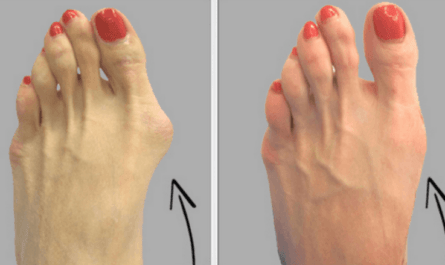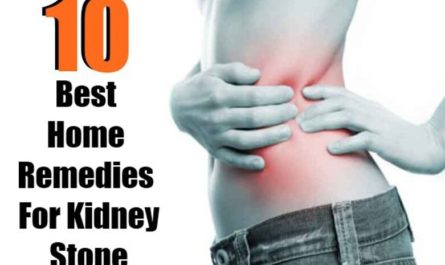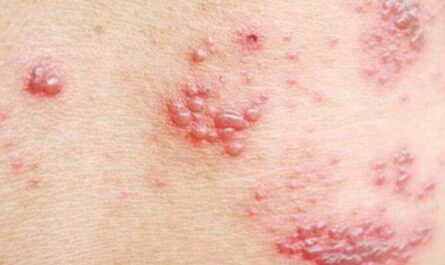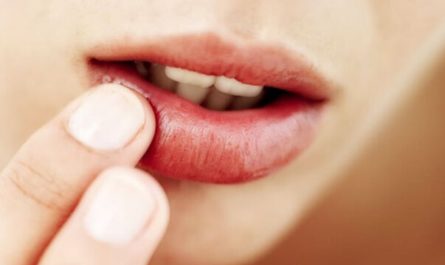Striae, or Striae distensae,is also known as stretch marks in layman’s terms. It appears as zigzag streaks on human skin when there is rapid growth in the human body, like in puberty, underlying illness, and pregnancy. It usually appears as scarring on the skin due to the tear of the dermis into off-color streaks.
These stretch marks usually appear on the abdomen, breasts, hips, buttocks, or other parts of the skin of the human body. The appearance of stretch marks is very common in pregnant women, especially during their last trimester when the baby forces stretching in the abdomen.
Stretch marks are neither painful nor harmful, but they do make the person’s skin look bad, and many people are not comfortable with the appearance of these stretch marks.
Although these stretch marks do fade over time but don’t go away completely (Wollina & Goldman, 2017), treatment may help eliminate stretch marks to some extent. This article highlights some treatments and prevention measures to get rid of stretch marks quickly.
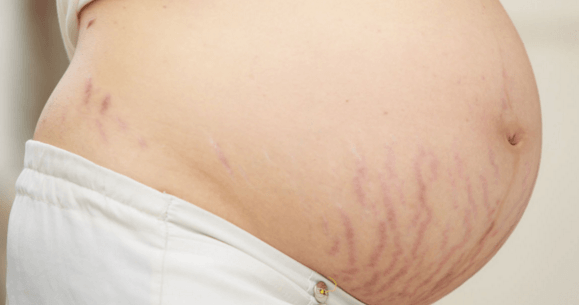
Symptoms of Stretch Marks
All the stretch marks don’t look alike and vary from person to person. The reasons behind the different kinds of stretch marks usually depend on how long these stretch marks have been on you, the reason that caused them, the location of these stretch marks on your body, and your skin type.
Some of the known common variations (Poulsen et al., 2018) are as follows:
- Streaks or lines on any part of the skin on the body, predominantly on the abdomen, breasts, hips, and buttocks.
- Different colors like pink, red, black, blue, and purple.
- Stretch marks can be streaks that fade from a brighter to a lighter hue.
- It may cover large areas of the skin on your body
Stretch Marks Causes and Risk Factors
Stretch marks start to appear on the skin when there is rapid growth in your body due to different reasons, and your skin can’t stretch enough to keep up with this rapid growth.
The presence of a protein known as Collagen helps skin be more elastic, allowing it to stretch. Any deficiency of this protein in your body can also cause stretch marks when there is growth in your body.
The human skin consists of three key layers, and the stretch marks form in the middle layer, also known as the dermis. The stretch marks appear when the connecting tissue is stretched beyond the maximum elastic limit. This happens when there is rapid expansion or contraction of the skin.
As the human body grows, the connecting tissues in the dermis slowly stretch to accommodate the slow growth, but rapid growth causes sudden stretching of the skin beyond its elastic limit. The deeper layers of skin show through because of tears in the dermis resulting in stretch marks.
Over time, stretch marks fade to silvery, white, or glossy streaks. The pale fat beneath the skin becomes visible and hides the blood vessels beneath.
8 Common Causes of Stretch Marks
You may get stretch marks because of the following reasons (Ud‐Din et al., 2016):
1. Pregnancy
Pregnancy is one of the biggest factors for women to develop stretch marks on their bodies due to stretched skin due to the growth of the baby inside the abdomen and other hormonal changes. These stretch marks might fade with time after the delivery.
Stretch marks caused by pregnancy are known as Striae gravidarum. During pregnancy, a woman’s abdomen grows to accommodate the growing fetus, which causes the skin to stretch. Even the breasts grow to prepare to produce milk for the newborn.
Other parts of a woman, like the thighs, hips, lower back, and buttocks, may also become large and develop stretch marks during pregnancy. Stretch marks start fading over a while and may become less noticeable around 6 to 12 months after delivering the child.
2. Rapid increase in weight
The rapid increase in weight can result in stretch marks in both men and women. This rapid increase in weight can be because of a bad lifestyle, including poor food habits and less physical activity.
3. Bodybuilding
The Stretch marks may appear on the bodies of bodybuilders depending on the intensity of their training and diet to gain weight quickly. Bulging of muscles may also cause stretch marks on the body of bodybuilders. Bodybuilders can also develop stretch marks if they stop training.
4. Rapid weight loss
The stretch marks can appear with rapid weight loss as well. The rapid weight loss can be due to following a weight loss program or an underlying health issue.
5. Grow Fast
Children grow quickly during puberty; you often can find that children are outgrowing their new clothes within a few weeks of buying them new ones. After infancy, children grow the fastest and have big growth spurts, usually at puberty. These big spurts in growth can result in the stretching of skin too quickly and cause stretch marks.
6. Genetics
Genetics and type of skin may also play their part in developing stretch marks on your body. If stretch marks run in your heredity, you have more chances of developing them.
7. Genetic diseases
Some genetic diseases, like Marfan syndrome, which weakens fibers in the skin and causes unusual growth, may also cause stretch marks. Ehlers-Danlos Syndrome (EDS), resulting in collagen changes, also causes stretch marks.
Developing illnesses like Cushing’s syndrome may result in stretch marks.
8. Medical reasons
Stretch marks may also develop because of plastic surgery and breast implant surgery. Consuming large amounts of steroids for medical reasons also may result in you developing stretch marks on your skin.
Stretch Marks Risk factors.
Researchers have associated various risk factors (Farahnik et al., 2017) that may cause stretch marks, but the evidence varies. A lot more work needs to be done to confirm the causes of stretch marks.
Some of the risk factors associated with tearing of skin and developing of stretch marks could be linked to:
- Genes and type of skin – family history
- Chronic underlying disease(s)
- Body mass index (BMI) before pregnancy, obese women carrying larger babies
- Size of the child being carried by women during pregnancy
- Prolonged use of steroids for medicinal purposes or for gaining muscles
- Age-related changes in skin collagen
Diagnosis
Stretch marks (Oakley & Patel, 2020) are visible to the human eye and can be easily diagnosed by a doctor examining the skin. The doctor is going to enquire about the person’s medical history. The doctor may ask a few questions based on signs and symptoms and any medications the person is on for existing health issues.
Stretch marks are not known to be painful and usually do not cause any harmful effects. Although, in some rare cases, an underlying health problem that requires treatment or monitoring may be the reason for the appearance of stretch marks.
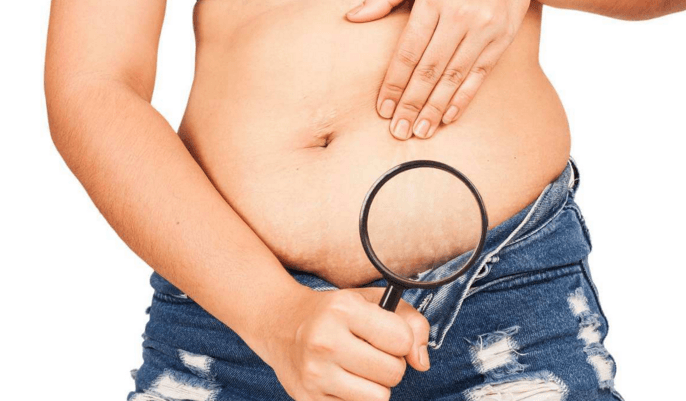
Stretch Marks Treatment and Prevention
Different pharma brands claim that their creams, ointments, gels, oils, and lotions effectively get rid of stretch marks. Some topical treatments claim their preparation of active ingredients, when applied to the skin’s surface, can help eliminate stretch marks. But there is very little medical evidence to suggest that is the case.
Cosmetic surgery has also been proposed as an effective treatment for removing stretch marks, although it can have its drawbacks.
Any treatment for getting rid of stretch marks can be a costly affair, and it is unlikely that health insurers will fund the treatment unless there is some underlying health issue. Removal of stretch marks is considered a cosmetic treatment and are rarely funded by insurer.
As a cheap solution, you can also use makeup to conceal stretch marks on exposed areas of the body. Other methods (Brennan et al., 2018) to treat stretch marks include;
1. Exfoliate
Regular exfoliation is the best way to treat the issue of stretch marks. Exfoliation removes dead cells from the body and lightens the stretch marks.
2. Topical treatments
Some topical ointments are very effective in minimizing the appearance of stretch marks. The GP prescribes some, and some are available OTC.
These are very effective in lightening the stretch marks’ tone. However, they may or may not be able .to remove the stretch marks completely
3. Microdermabrasion
Microdermabrasion involves the spraying of minute exfoliating crystals on the stretch marks (affected area). These crystals break up the upper layer of the skin (epidermis), pull out the dead and damaged cells in that skin, and tighten collagen. A tipped wand-like instrument is rubbed over the region that stimulates the skin and helps in treating stretch marks.
4. Micro-needling
Micro-needling is an invasive treatment targeting the dermis, aka corium (the thicker, deeper layer of the skin), where stretch marks form. During this collagen induction therapy, tiny needles are poked into your skin to stimulate the body’s natural production of elastin and new collagen to enhance your skin’s appearance. This promotes skin regeneration and repairs scarring to reduce stretch marks.
5. Laser therapy
Laser therapy involves penetrating lasers deep within the skin to get rid of the white stretch marks. The lasers stimulate the melanin (protective skin pigment), making striae smoother, thereby minimizing their appearance.
6. Cosmetic surgery
A tummy tuck (plastic surgery of the abdomen), medically termed an abdominoplasty, is a cosmetic surgery technique to eliminate stretch marks. The surgery tightens a thin casing of connective tissue in the abdomen (fascia) with sutures. The surgery makes the abdomen skin look fine and firmer. But one needs to remember that the surgery could leave marks and scars of its own.
7. Medicinal creams
Applying medicinal creams like corticosteroids may cause stretch marks after prolonged use, as they can break down the connecting tissues in the skin. Consuming corticosteroid medicine like prednisone orally for long periods can have a similar adverse effect and result in stretch marks on your skin.
Stretch Marks Prevention
You cannot prevent stretch marks from appearing when your body is undergoing rapid change in size. However, you can reduce the risk of developing stretch marks by following the below-mentioned tips (Moore et al., 2012).
- Ensure you maintain a healthy weight and keep your BMI in the healthy range.
- Certainly, stay away from yo-yo dieting, which is harmful because of repeated cycles of weight gain and weight loss.
- Ensure you eat a balanced diet that is rich in vitamins and minerals daily. Consume foods with the required amount of vitamins A and C and have enough minerals like zinc and silicon because they are good for your skin.
- Try to devote some time to light workouts and walks, and watch what you eat to slow down weight gain during pregnancy.
- Ensure you drink at least six to eight glasses of water every day to keep yourself properly hydrated, which is good for your skin.
Takeaway
Stretch marks may not be good sight, but they are common and mostly fade out over a while. Stretch marks do not pose any health risks and do not cause any pain, and are not harmful. Undergoing any treatment for getting rid of stretch marks is to improve your appearance.
However, do consult your doctor because there may be an underlying health issue that may have caused the appearance of stretch marks due to rapid changes in your body. Start loving yourself for who you are and not for how you look.

